Be in the Know
Elevate your industry knowledge with PT articles and insights crafted by experienced industry experts
Battle rope exercises are highly popular amongst athletes, personal trainers and other fitness enthusiasts looking for fun, variety and results from their workouts.
In a 2013 study published in the Journal of Strength and Conditioning, it was concluded that battle rope exercises trigger higher metabolic response than traditional resistance training. A 2015 study also concluded that cardiorespiratory fitness can be increased with only a ten-minute vigorous battle rope workout.
It is for this reason that these exercises are fast becoming the conditioning tool of choice for personal trainers working with clients wanting to shed serious weight while simultaneously developing strength, power and endurance.
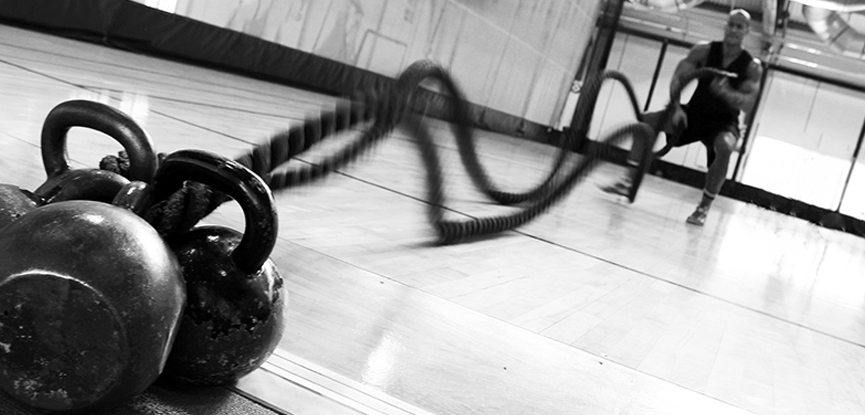
The exercises are typically more suited to an interval style where the intensity is measured by time, although it is possible to structure a rope workout using the more conventional sets and reps approach. They are routinely used in HIIT (High intensity interval training) type sessions where they are alternated with a lower intensity activity or exercise, which may or may not be another rope exercise.
They are also commonly used at the end of a workout as a ‘metabolic finisher’ to maximise the effectiveness of the session and to ensure that every last muscle fibre has been exhausted.
The ropes themselves vary in length, diameter and as a result, weight. Most workouts will start with a 1.5-inch rope and will progress to a 2-inch rope when strength and form improve. Naturally, thicker ropes of the same length are heavier, but there are other ways to alter the training load.
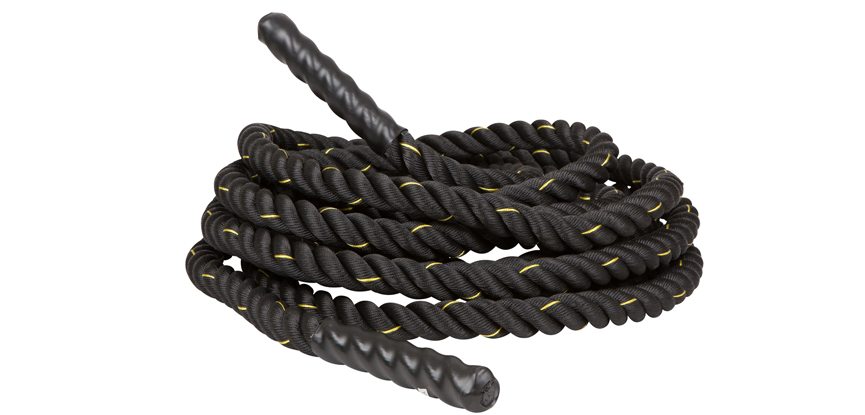
Longer and thicker ropes are heavier than shorter thinner ropes. Additionally, the load is inversely related to the tension of the rope. When the rope is slack, the rope is pulled towards the ground by gravity and as such more work/effort is required to overcome the gravitational forces acting upon it. When the rope is tighter, the load is reduced and the force against which the body has to work is reduced.
The ease by which the load of these exercises can be changed by simply moving towards and away from the anchor point makes them highly versatile. Transitions between intervals and exercises can be drastically reduced, further adding to the intensity of the workout.
Lower intensity variations of the same movement (more rope tension) can be alternated with higher loads (less rope tension) in an interval style session to provide active recovery. The work-to-recovery ratio can be determined by time, or could also be defined by a target heart rate using a reliable heart rate monitor.
The benefits of battle rope training are plentiful; while the exercises primarily use the arms and shoulders to move the ropes, the whole body must work to provide stability – this is why they are so functional. Furthermore, because the arms work independent of each other, strength is developed symmetrically, reducing the likelihood of muscle imbalances.
The direction in which the rope can move is not bound by a track, cam, lever or pulley system; the movements can be performed in almost any direction allowing the exercise to be subtly altered to match the specific training needs of the exerciser or athlete. For example, if an exerciser needed to work on their rotational strength, it’s really easy to integrate a little more torso rotation into the exercise.
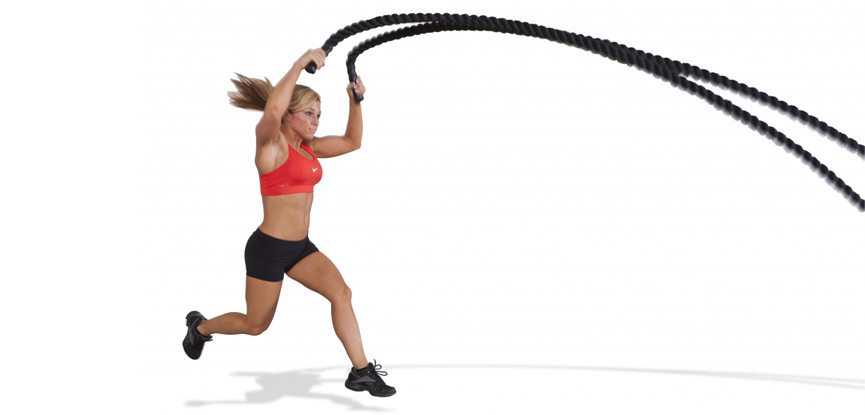
Rope exercises normally employ large bodily movements with the bulk of the movement being created by the arms and shoulders, but support and momentum being generated from the hips and knees. The rope exercises are performed in an explosive fashion with maximum effort being applied to every repetition.
True rope exercises are highly anaerobic, making any more than two to three minutes of continuous work is unlikely. Most battle rope intervals will start with about 30 seconds of work and will gradually increase in time and/or sets as progress is made. Intensity can also be increased by reducing the rest periods between intervals. All battle rope programmes should however really focus on improving the quality of movement and technique before any additional intensity or work is added.
So, know that you know what the ropes are, the benefits of using them and how to vary the intensity, here are five different exercises that are guaranteed to set your heart, lungs and shoulders on fire.
Start with a work to rest ratio of 1:3. Perform around 30 seconds of work to start with and take 90 seconds’ active recovery before starting your next set or exercise. If the first session this is tolerable, increase the duration of the work period by 15 seconds with each workout until you find your tipping point. Naturally, the rest will also need to be increased accordingly to maintain the 1:3 ratio.
Double Arm Waves
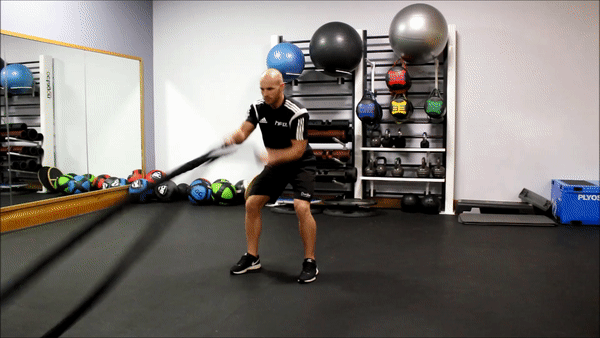
Adopt an athletic stance with the feet hip distance apart, the knees and hips soft and with the toes pointing towards the anchor point. Start with the rope at knee height, raising both arms up to approximately shoulder height. Lower the ropes back to the knees and repeat the action in a rhythmic and continuous nature.
Double Arm Slams
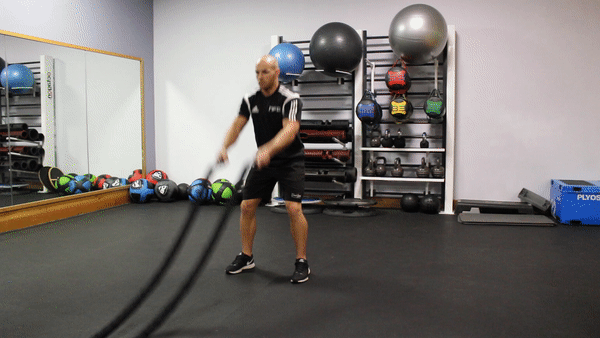
Adopt the same athletic stance as described above, ensuring that there is plenty of slack in the rope so that it does not feel like the rope is pulling you forwards. Start the movement with the arms by the side and the palms facing backwards. Extend the body into an upright posture while raising both arms to approximately shoulder height. At the end of the lifting phase, be sure to get up on to the toes. From the top of the movement, slam the ropes back towards the ground, allowing the arms to move back to the start position. Repeat the action in a rhythmically and continuously.
Snakes
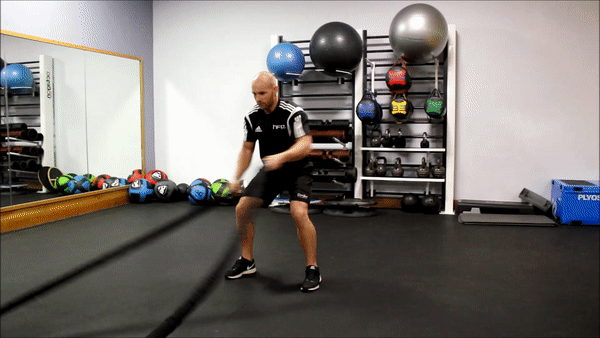
From the same athletic stance, place the hands together to the front of the body. Keeping the knee and hips soft throughout, initiate the movement by taking each arm out to the side and then bringing it back to the centre, creating a side-to-side waving action. Ensure that the movement originates from the shoulder and not the elbows or wrists. Again, perform this action continuously to create a slithering snake action in the rope.
Figure Eight Circles
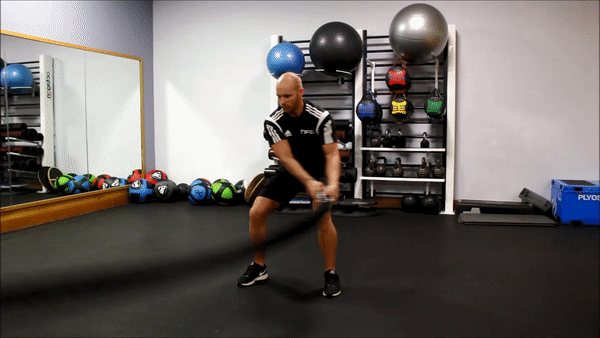
With the same set-up as all of the previous movements, place the hands and ropes together to the front of the body. Brace the abdominals, then begin by rotating the hands and ropes together to create a figure eight shape. Rotate the shoulders and the hips to take some of the load of the spine and be sure to keep the knees soft throughout.
Rainbows
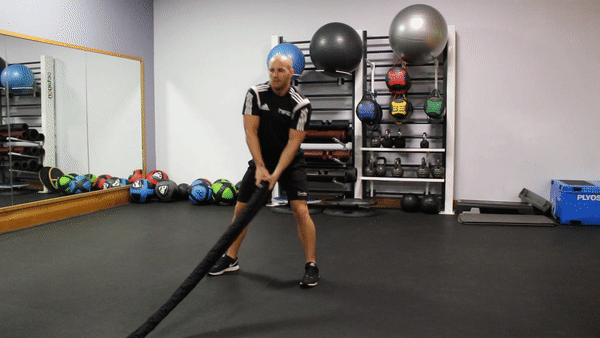
Start the exercise from the same athletic position but with the hands at head height and the elbows facing forwards. The hands should be under the ropes. Rotating from the hips and spine, explosively pivot the body while flipping the ropes up and over in the shape of a rainbow. Perform the action to the opposite site to create a continuous and rhythmic wavelike motion.
Did you find this article useful? Be sure to check out more of our articles using the button below.
Back to articlesAnd get the fast-paced world of personal training delivered straight to your inbox every week
Great news, you're on the list...